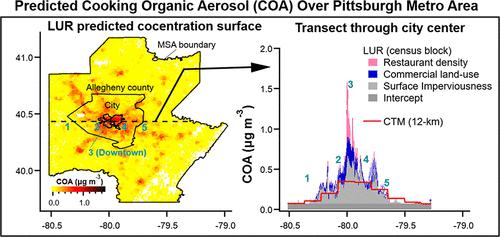当前位置:
X-MOL 学术
›
Environ. Sci. Technol.
›
论文详情
Our official English website, www.x-mol.net, welcomes your feedback! (Note: you will need to create a separate account there.)
National Exposure Models for Source-Specific Primary Particulate Matter Concentrations Using Aerosol Mass Spectrometry Data
Environmental Science & Technology ( IF 11.4 ) Pub Date : 2022-09-26 , DOI: 10.1021/acs.est.2c03398 Provat K Saha 1, 2 , Albert A Presto 1, 2 , Steve Hankey 3 , Benjamin N Murphy 4 , Chris Allen 5 , Wenwen Zhang 6 , Julian D Marshall 7 , Allen L Robinson 1, 2
Environmental Science & Technology ( IF 11.4 ) Pub Date : 2022-09-26 , DOI: 10.1021/acs.est.2c03398 Provat K Saha 1, 2 , Albert A Presto 1, 2 , Steve Hankey 3 , Benjamin N Murphy 4 , Chris Allen 5 , Wenwen Zhang 6 , Julian D Marshall 7 , Allen L Robinson 1, 2
Affiliation

|
This paper investigates the feasibility of developing national empirical models to predict ambient concentrations of sparsely monitored air pollutants at high spatial resolution. We used a data set of cooking organic aerosol (COA) and hydrocarbon-like organic aerosol (HOA; traffic primary organic PM) measured using aerosol mass spectrometry across the continental United States. The monitoring locations were selected to span the national distribution of land-use and source-activity variables commonly used for land-use regression modeling (e.g., road length, restaurant count, etc.). The models explain about 60% of the spatial variability of the measured data (R2 0.63 for the COA model and 0.62 for the HOA model). Extensive cross-validation suggests that the models are robust with reasonable transferability. The models predict large urban–rural and intra-urban variability with hotspots in urban areas and along the road corridors. The predicted national concentration surfaces show reasonable spatial correlation with source-specific national chemical transport model (CTM) simulations (R2: 0.45 for COA, 0.4 for HOA). Our measured data, empirical models, and CTM predictions all show that COA concentrations are about two times higher than HOA. Since COA and HOA are important contributors to the intra-urban spatial variability of the total PM2.5, our results highlight the potential importance of controlling commercial cooking emissions for air quality management in the United States.
中文翻译:

使用气溶胶质谱数据的源特定初级颗粒物浓度的国家暴露模型
本文调查了开发国家经验模型以预测高空间分辨率下稀疏监测空气污染物的环境浓度的可行性。我们使用了在美国大陆使用气溶胶质谱法测量的蒸煮有机气溶胶 (COA) 和类碳氢化合物有机气溶胶(HOA;交通主要有机 PM)数据集。选择的监测地点涵盖土地利用和源活动变量的全国分布,这些变量通常用于土地利用回归建模(例如,道路长度、餐馆数量等)。这些模型解释了大约 60% 的测量数据的空间变异性 ( R 2COA 模型为 0.63,HOA 模型为 0.62)。广泛的交叉验证表明这些模型是稳健的,具有合理的可转移性。这些模型预测城市地区和道路走廊沿线的热点存在较大的城乡和城市内部变异性。预测的国家浓度表面显示出与源特定的国家化学物质传输模型 (CTM) 模拟合理的空间相关性(R 2:COA 为 0.45,HOA 为 0.4)。我们的测量数据、经验模型和 CTM 预测均表明 COA 浓度比 HOA 高约两倍。由于 COA 和 HOA 是城市内总 PM 2.5空间变异性的重要贡献者,我们的结果强调了控制商业烹饪排放对于美国空气质量管理的潜在重要性。
更新日期:2022-09-26
中文翻译:

使用气溶胶质谱数据的源特定初级颗粒物浓度的国家暴露模型
本文调查了开发国家经验模型以预测高空间分辨率下稀疏监测空气污染物的环境浓度的可行性。我们使用了在美国大陆使用气溶胶质谱法测量的蒸煮有机气溶胶 (COA) 和类碳氢化合物有机气溶胶(HOA;交通主要有机 PM)数据集。选择的监测地点涵盖土地利用和源活动变量的全国分布,这些变量通常用于土地利用回归建模(例如,道路长度、餐馆数量等)。这些模型解释了大约 60% 的测量数据的空间变异性 ( R 2COA 模型为 0.63,HOA 模型为 0.62)。广泛的交叉验证表明这些模型是稳健的,具有合理的可转移性。这些模型预测城市地区和道路走廊沿线的热点存在较大的城乡和城市内部变异性。预测的国家浓度表面显示出与源特定的国家化学物质传输模型 (CTM) 模拟合理的空间相关性(R 2:COA 为 0.45,HOA 为 0.4)。我们的测量数据、经验模型和 CTM 预测均表明 COA 浓度比 HOA 高约两倍。由于 COA 和 HOA 是城市内总 PM 2.5空间变异性的重要贡献者,我们的结果强调了控制商业烹饪排放对于美国空气质量管理的潜在重要性。



























 京公网安备 11010802027423号
京公网安备 11010802027423号